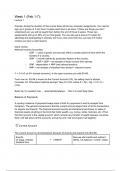Week 1 (Feb 1-7);
Lecture 1
Prenote; during the duration of this course there will be two computer assignments. You need to
sign up in groups of 4 and have 3 weeks each time to do them. If there are things you don’t
understand yet, you will be taught them before the end of those 3 weeks. These two
assignments add up to 25% of your final grade. You can also get a bonus 0.5 marks for
attending and participating in tutorials, but if you miss more than two, you lose 0.5 marks
(unless you have a valid reason).
Quick review;
National Income Accounting
- GDP → value of goods and services within a certain period of time within the
borders of a country.
- GNP → income earned by production factors of the country.
- GNP = GDP + net receipts of factor income from abroad.
- GNP - depreciation = NNP (net national product)
- NNP + net receipts of transfers from abroad = national income.
Y = C+I+G so S=I (closed economy). In the open economy you add EX-IM.
From now on, EX-IM is known as the Current Account (CA). So selling more to abroad
increases CA. What about national savings? Now S=I+CA, where S = Sp + Sg = (Y-C-T) +
(T-G).
Exam tip; if a question has … automatically/always … then it is most likely false.
Balance of Payments
A country’s balance of payments keeps track of both it’s payments to and its receipts from
foreigners. The general consensus is that the current account keeps track of all the transactions
for exports and imports. The financial account records all international purchases or sales of
financial assets (anything in the form that holds wealth, e.g. money, sticks, factories, etc.) Then
the third account is the capital account, which records any transfer of wealth between countries.
Next I will talk about all the accounts, and at the end I will summarize it all together.
1) Current Account;
The current account is all transactions because of imports and exports (CA=EX-IM).
Exports Now we add credits and subtract
Or wage, interest, + CREDIT debits. CA balance = Credit - Debit.
dividend from
, abroad, etc.
Imports
Or wage, interest, - DEBIT
dividend to abroad,
etc.
2) Financial Account;
The financial account is all transactions due to international purchase or sale of financial assets.
Sale of asset to Note; the textbook uses opposite
abroad + CREDIT notation.
FA balance = Debit - Credit
Purchase of asset If you sell more than you buy, your
from abroad - DEBIT financial account balance is
negative.
3) Capital Account;
Transactions due to special sorts of intangible capital (like copyrights, patents, debt cemission)
appear on the capital account.
Examples of BoP questions are as follows;
, Use these to understand when which account
is used and how the debit/credit system
works. It is different to how it was in
accounting (a little) so can get confusing if
you do not practice.
To get the balance of payments (BoP) you use the following formula;
𝐶𝑢𝑟𝑟𝑒𝑛𝑡 𝐴𝑐𝑐𝑜𝑢𝑛𝑡 + 𝐶𝑎𝑝𝑖𝑡𝑎𝑙 𝐴𝑐𝑐𝑜𝑢𝑛𝑡 + 𝐹𝑖𝑛𝑎𝑛𝑐𝑖𝑎𝑙 𝐴𝑐𝑐𝑜𝑢𝑛𝑡 = 0
Official international reserves are things like gold, foreign currency, etc. held by the central bank.
This is needed to couchon against financial instability.
Reserves in hand of foreign CB = + credit on the financial account
Reserves in hand of own CB = - debit on financial account.
Let's take a review of what this all is (as it is quite confusing). When working with BoP, every
transaction has two sides, as seen in the examples above and in the book on pages 363-364. In
theory, the balance of payments is 0. The financial account looks at the difference between
acquisitions of assets from foreigners and the buildup of liabilities to them. The current account
looks at the difference between sales of goods and services to foreigners and purchases of
goods and services to them. However, when adding up the numbers we get that balance of
payments might not be zero. Hence, we use ‘statistical discrepancy’. This basically means
‘accounting for communications error’. Since information comes from so many sources, it is
hard to make sure everything is perfectly in check, so this statistical discrepancy is added to
bring the BoP back to zero. The role central banks play in offsetting the current account balance
can be seen through the balance of payments. This is the level of net central bank financial
flows (official settlements balance). Let's say a country has a 1 billion current account deficit, but
a non reserve surplus of 500m. The central bank would have to sell 500m of their reserves to
offset this. I recommend doing question 5 from chapter 13 again, it really portrays the thinking
you need. Note; in this question, when it asks for the balance of payments it refers to the one of
the central bank, hence, how much the central bank had to pay to offset this and make the
overall BoP back to 0. Furthermore, a foreign exchange intervention is when central banks buy
or sell international reserves in private asset markets to affect macroeconomic conditions.
The following is a picture of part of chapter 13 summary;
,





